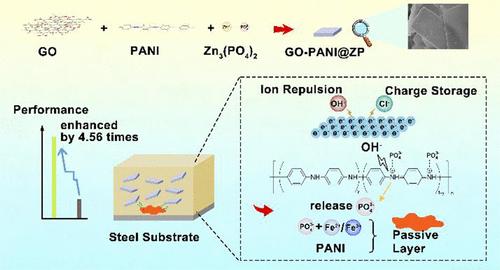GO-PANI@ZP复合材料的原位合成及长期缓蚀性能
IF 3.9
3区 工程技术
Q2 ENGINEERING, CHEMICAL
引用次数: 0
摘要
本研究通过原位聚合和逐步离子引入成功合成了石墨烯oxide-polyaniline@zinc磷酸盐(GO-PANI@ZP)复合材料。以氧化石墨烯(GO)为衬底,聚苯胺(PANI)和磷酸锌(ZP)的顺序沉积降低了亲水性,减少了层间团聚。层状结构提供了延伸腐蚀介质渗透路径的物理屏障。聚苯胺具有氧化还原可逆性,可动态调节电荷转移,促进电化学保护层的形成。质子化聚苯胺响应腐蚀反应并释放腐蚀抑制剂。此外,复合材料表现出微电容器效应,在涂层-衬底界面建立稳定的电荷势垒,阻止腐蚀性物质的渗透。在3.5 wt % NaCl溶液中浸泡168 h后,复合涂层的总阻抗值是环氧树脂的4.56倍,表现出优异的耐腐蚀性。本研究为开发有机-无机复合防腐材料提供了一种新的设计策略。本文章由计算机程序翻译,如有差异,请以英文原文为准。

In Situ Synthesis and Long-Term Corrosion Inhibition Performance of GO-PANI@ZP Composite
This study successfully synthesized a graphene oxide-polyaniline@zinc phosphate (GO-PANI@ZP) composite through in situ polymerization and stepwise ion introduction. Using graphene oxide (GO) as the substrate, the sequential deposition of polyaniline (PANI) and zinc phosphate (ZP) mitigates the hydrophilicity and reduces interlayer agglomeration. The lamellar structure provides a physical barrier that extends corrosive media penetration pathways. PANI contributes redox reversibility to dynamically regulate charge transfer, facilitating the formation of an electrochemical protective layer. Protonated PANI responds to corrosion reactions and releases corrosion inhibitors. Additionally, the composite exhibits a microcapacitor effect, establishing a stable charge barrier at the coating-substrate interface that impedes corrosive species penetration. After 168 h of immersion in 3.5 wt % NaCl solution, the composite coating demonstrated a total impedance value 4.56 times that of epoxy resin, revealing exceptional corrosion resistance. This work provides a novel design strategy for developing organic–inorganic composite anticorrosion materials.
求助全文
通过发布文献求助,成功后即可免费获取论文全文。
去求助
来源期刊

Industrial & Engineering Chemistry Research
工程技术-工程:化工
CiteScore
7.40
自引率
7.10%
发文量
1467
审稿时长
2.8 months
期刊介绍:
ndustrial & Engineering Chemistry, with variations in title and format, has been published since 1909 by the American Chemical Society. Industrial & Engineering Chemistry Research is a weekly publication that reports industrial and academic research in the broad fields of applied chemistry and chemical engineering with special focus on fundamentals, processes, and products.
 求助内容:
求助内容: 应助结果提醒方式:
应助结果提醒方式:


